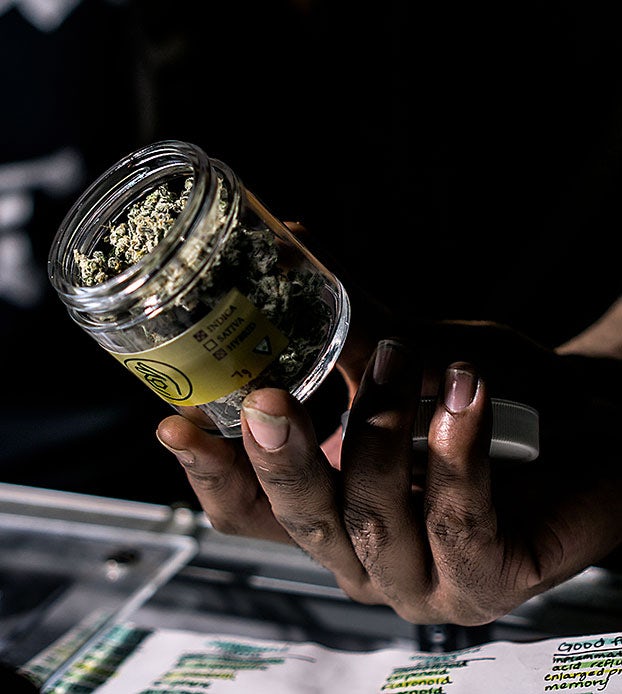There’s a lot of information out there about cannabis these days — and it’s not all accurate. For instance, in the excitement over the seemingly miraculous healing potential of CBD, THC can become unfairly demonized. And while CBD does have some pretty incredible qualities, it’s a good idea to have a realistic understanding of both its benefits and its limitations.
Let’s set the record straight about some common misconceptions and myths regarding CBD.
Myth 1: CBD is the “good” cannabinoid and purely medical while THC is the “bad” cannabinoid and purely recreational
False.
Both cannabinoids have a lot to offer, and neither are inherently “good” or “bad.” Although, if you mean one is medicinal and the other recreational, both CBD and THC have a firm claim for being both.
THC is known for providing the controversial, mind-altering, recreational high. However, it is replete with medicinal benefits as well. For example, THC treats pain, soothes nausea, reduces inflammation, and can improve metabolism.
CBD also treats pain and reduces inflammation. CBD has other medical uses as well, such as the potential to treat anxiety, and depression. Perhaps most famously, CBD is used to reduce epilepsy related seizures.
Numerous studies have also shown both THC and CBD to be effective in relieving many of the negative side effects that cancer patients battle with. It can be dramatically helpful in treating nausea and GI symptoms associated with chemotherapy along with significant weight loss and wasting (cachexia) associated with cancer. Early research even suggests that CBD and THC might be disease modifying in cancerous tumor growth.
Furthermore, medical benefits of cannabis are often seen to be more effective when both CBD and THC are present — something known as the “entourage effect.”
As for recreational use, THC is typically what people think of as the desired cannabinoid. However, while CBD is not specifically “recreational” in spirit, plenty of recreational users seek out strains with higher CBD because of its ability to naturally reduce the potential for THC-induced anxiety — as well as its ability to inhibit some of the more extreme psychoactive qualities of THC. In other words, the presence of CBD allows for a more relaxed recreational high.
Myth 2: CBD is not psychoactive — and psychoactivity is an inherently negative side effect
Untrue.
The word “psychoactive” is often given a narrow definition that is both limiting and, frankly, inaccurate.
In fact, CBD and THC are both psychoactive, though in quite different ways.
Given that CBD has the potential to affect mood, that is indeed affecting our psyche. And CBD purportedly affects mood, including anxiety, depression, and mood elevation.
That said, while CBD is most certainly psychoactive, it is NOT an intoxicant or psychotropic. This is what most people think of when they hear the word psychoactive. So, to be clear, CBD is not impairing or hallucinogenic and creates no “high.”
However, while we’re on the subject, it’s important to note that even the kind of psychoactivity that gets you “high,” such as some of the psychoactive effects of THC, is not inherently bad. In fact, the euphoria it creates may be therapeutic too, as many people find the effects to be calming and uplifting.
Myth 3: CBD is most effective when used without THC
This is not always true, and they often work together hand in hand. As noted above, CBD and THC are like best friends. These two cannabinoids work together synergistically, meaning they support one another and are most effective when taken together.
For example, one study found that whole plant CBD was twice as effective for treating epilepsy, as compared to CBD isolate. Furthermore, lower doses were required to achieve a therapeutic effect.
In fact, cannabis and hemp plants contain a huge variety of cannabinoids which we are only beginning to understand. One thing seems evident, however — these cannabinoids seem to work best when used in unison. This is known as the entourage effect.
For example, a study done by Spanish doctors found that whole-plant cannabis was far more effective in three types of breast cancer than pure THC used alone. Another study done by British doctors indicates that CBD helps to potentiate THC in treatment of arthritis.
While there are situations in which pure CBD might be preferable to whole-plant cannabis — as it depends on the condition and changes from patient to patient — evidence indicates that the combination of cannabinoids is generally more effective for most medical treatments.
Myth 4: CBD derived from hemp isn’t as good as CBD derived from cannabis
This one is a bit trickier. CBD is the same whichever plant it is derived from — in theory. It would be more accurate to say that CBD as an isolate is the same wherever it is sourced.
Hemp is simply the name for cannabis plants that have less than 0.3% THC, whereas cannabis or marijuana refer to plants that have more than 0.3% THC.
While it is true that pure CBD will be the same compound whichever plant it comes from, if you’re going for the whole plant, the entourage effect of the various cannabinoids working together, the hemp plant could be less effective in certain treatments.
Another issue comes up in the sourcing of quality CBD. All cannabis plants are excellent at phytoremediation. This means that cannabis plants actually clean the environment of toxins such as heavy metals and radioactive strontium-90 (one more incredible attribute of this plant!). The problem with this is that it is very easy to wind up with contaminated plant material.
Hemp-derived CBD can contain larger amounts of contaminants, as it requires more acres to be cultivated since hemp contains far less CBD than medical cannabis. If it is picking up toxins, it can also relay those toxins to you.
While it can be easier to source quality — meaning less contaminants and accurately labeled — CBD from medical cannabis due to its higher regulation in legal states, this isn’t always the case. The important thing here is to do your research when sourcing CBD, so you don’t wind up with plant material full of toxins.
Myth 5: CBD has no side effects
Actually, some people do experience unwanted side effects from using CBD. Potential side effects of CBD can include nausea, fatigue, and irritability. CBD can also interact with certain medications, such as the blood thinner coumadin.
Still, most studies generally conclude that CBD is overwhelmingly safe.
It’s understandable that with so much cannabis hype pouring into the zeitgeist, not all the information is going to be dependable. It’s also worth noting that scientists are learning — and publishing — more about the cannabis plant every day.
Sign up for bi-weekly updates, packed full of cannabis education, recipes, and tips. Your inbox will love it.

 Shop
Shop Support
Support
















